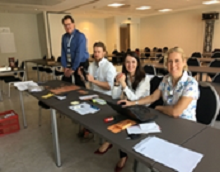Rasta 252 rezultatai (-ų)
Skip results of view Duomenų istorijos

- Data Story
To support organisations on their path to 'open by default', the Open Data Goldbook for Data Managers was created. This Goldbook, serving as a practical Open Data guide, is a summary of all you need to know to successfully implement an Open Data initiative within your organisation. You can expect this Goldbook to cover the basic organisational, technical and day-to-day challenges related to Open...

- Data Story
Today, 21 December, is the shortest day of the year in the Northern Hemisphere also known as Winter Solstice. In many countries, this day to mark the end of autumn and the start of winter and is therefore celebrated. The most famous example of a tradition concerning winter solstice is the Stonehenge monument in the United Kingdom, of which one side is aligned with today's sunset. While a query on...

- Data Story
It is that time of the year again. With the end of the year approaching fast, activities for the holiday season are already planned and everything is geared up for Christmas. Many European city centres come alive during this period with the arrival of a Christmas market, festive gatherings at the town's central squares or places and a sign the year is running to its end. Originating in Germany...

- Data Story
With December around the corner, people all over Europe are preparing themselves for winter traditions and gatherings such as New Year Eve, Christmas or other activities. While most of these activities are taking place in the warmth of everybody's houses, for many it is also the time of the year to go outside and have fun in the snow. Many of Europe's mountains will soon be covered in snow and be...

- Data Story
Open Data is made available in a wide variety of domains and for various reasons. One of the main reasons governments provide their citizens with Open Data is transparency. For example the city of Los Angeles has published data about accidents on its streets. Journalists have developed maps of the location of these accidents. Citizens understand now better that when construction is taking place at...

- Data Story
With August coming to its end, also the summer weather is about to leave and autum will soon arrive. While the last week of August is treating Europe well with some (last) rays of sunlight, the weather is about to change. All European countries also collect data about the weather, for example to use it for scientific research, traffic information or simply to forecast the weather itself. Many of...

- Data Story
The 31st Modern Olympic Summer games will start in Rio de Janeiro. Until the 21st of August, more than 10,000 athletes from over 200 different countries will compete in 28 different sports. This year there are three new sports introduced: golf, sevens rugby and kite surfing. The Olympic Games show that sport fanatics can be found around the whole world. But what if you are visiting a country and...

- Data Story
Between September 18 and September 20th, the INSPIRE 2018 conference took place in Antwerp Belgium. The motto of this year's edition was "INSPIRE users: Make it work together!" Following this motto, the European Data Portal facilitated a thinkathon on Wednesday September 19 th. The thinkathon - an interactive workshop format - created a new 'space' for the conference participants to 'make it work...

- Data Story
New technologies have made it possible to expose cultural heritage on digital platforms. However, until this moment only a small fraction of the cultural institutions worldwide digitised their material and made it openly available. You can read more about the importance of digitisation of open cultural heritage and its re-use. In fostering the process of digitisation of cultural heritage, cultural...

- Data Story
Background and aim of the PSI directive and its revision The aim of the PSI Directive on re-use of Public Sector Information is to foster and guide the re-use of Public Sector Information (PSI). The directive advocates making more public sector data and public research data available at higher quality to increase the reusability. A solid framework guides which data needs to be open and how...
